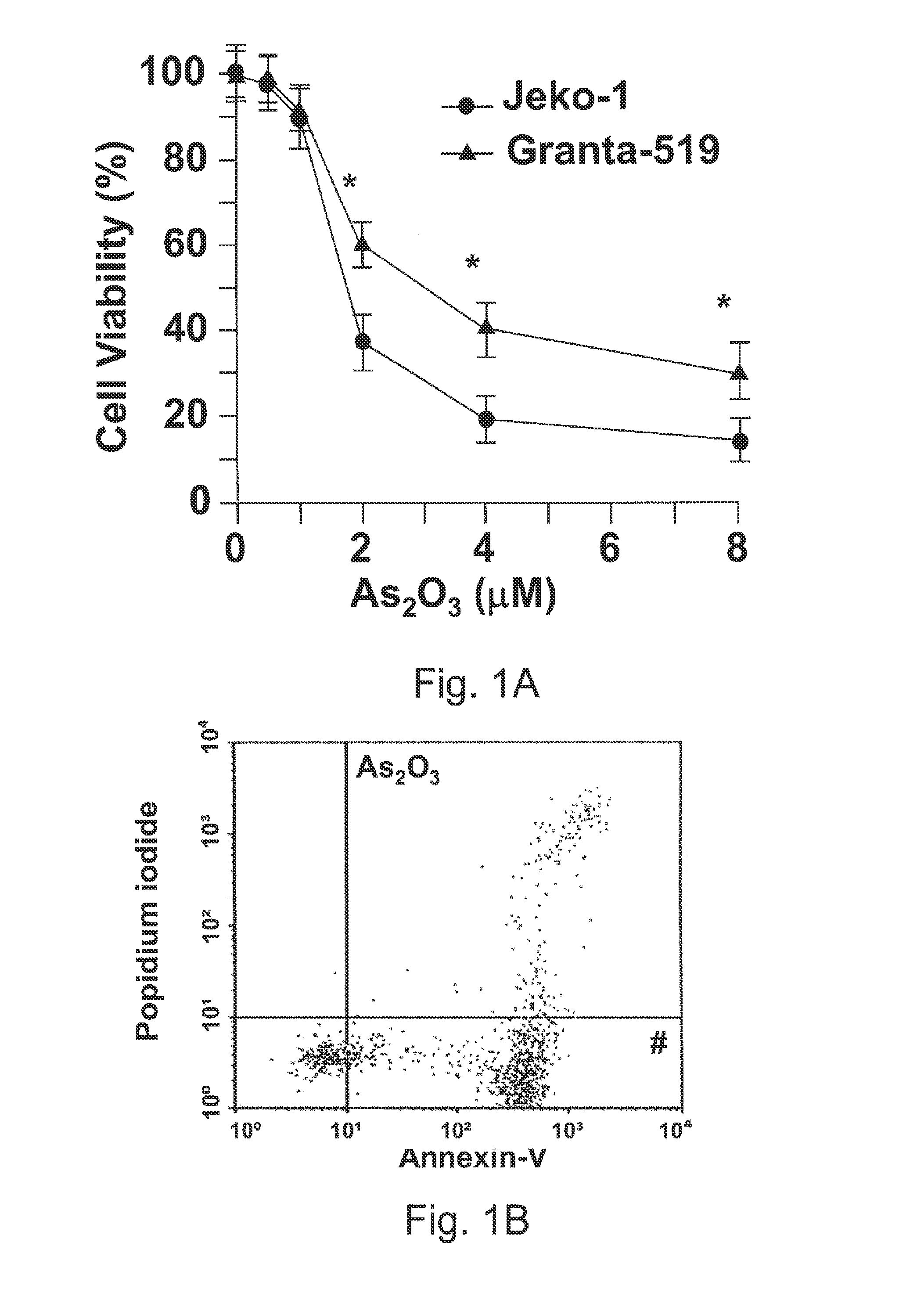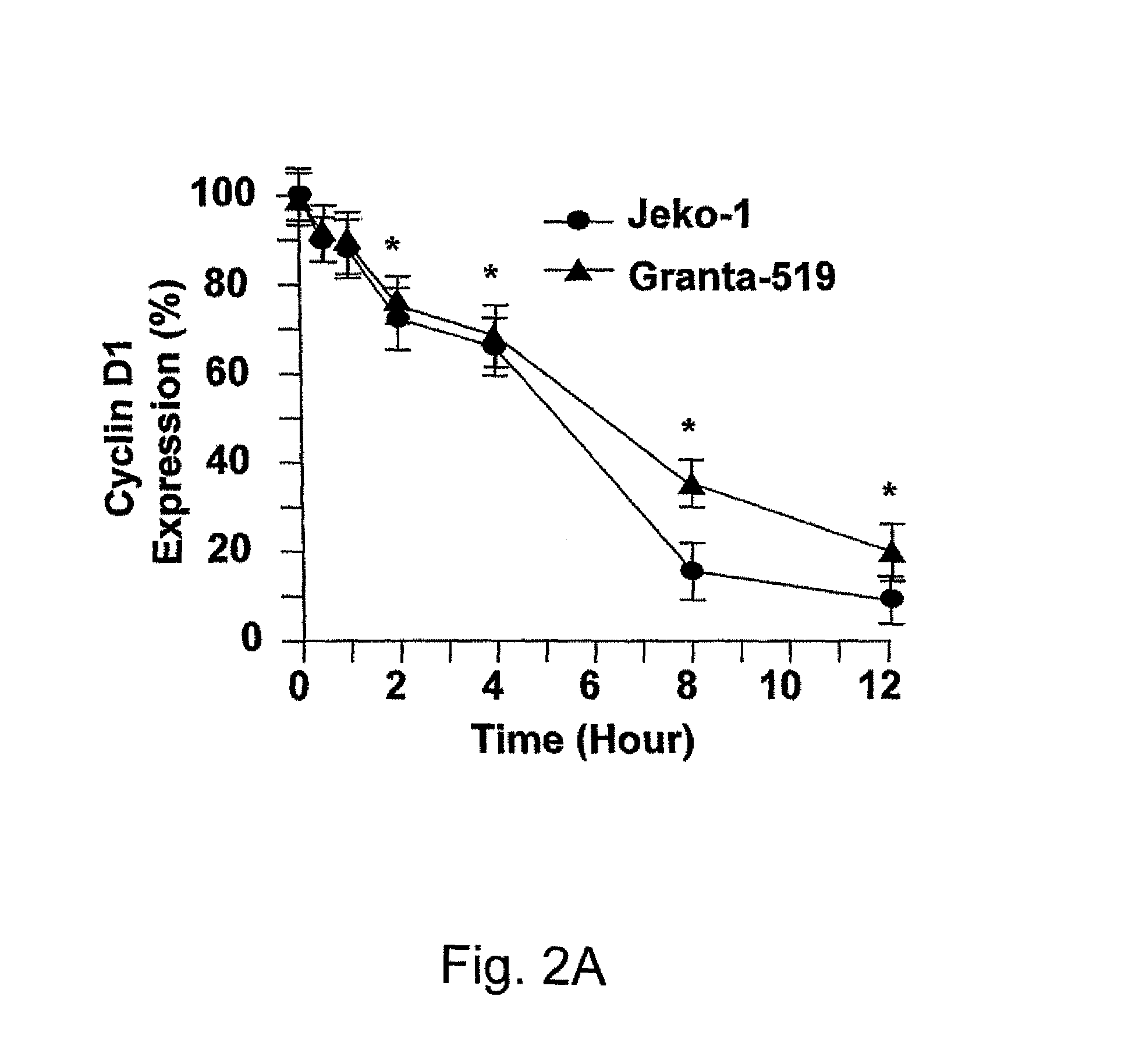Method for inhibiting cancer using arsenic trioxide
a technology of arsenic trioxide and cancer, which is applied in the direction of biocide, immunological disorders, drug compositions, etc., can solve the problems of difficult management, limited treatment options for relapsed patients, and relapses in most patients with prolonged follow-up
- Summary
- Abstract
- Description
- Claims
- Application Information
AI Technical Summary
Benefits of technology
Problems solved by technology
Method used
Image
Examples
example 1
In Vitro Studies Show As2O3 is Effective in Treatment of MCL by Targeting Cyclin D1
Materials and Methods
[0042]Cell lines. The MCL lines Jeko-1 and Granta-519 were obtained from German Collection of Microorganisms and Cell Cultures (ACC 553 and ACC 342, Braunschweig, Germany). Jeko-1 cells were cultured in RPMI 1640 with 20% fetal bovine serum (FBS), and Granta-519 cells in DMEM with 10% FBS; both with 50 units / ml penicillin and 50 μg / ml streptomycin, at 5% CO2.
[0043]Reagents and antibodies. Reagents and antibodies used included cell culture reagents (Invitrogen, Carlsbad, Calif., USA); kinase inhibitors and their inactive analogues (Calbiochem, Darmstadt, Germany); antiserum to phospho-GSK3 (tyrosine 216, Try-216) (Upstate, Lake Placid, N.Y., USA); antisera to cyclin D1, phospho-cyclin D1 (Thr-286), GSK3β, phospho-GSK3β (Tyr-216), IκB kinase (IKK)α / β, phospho-IKKα / β (serine 1761180, Ser-176 / 180), RB and phospho-RB (serine 795, Ser-795), caspase-3 and β-actin (Cell Signaling Technolo...
example 2
Clinical Study of Oral-As2O3 in the Treatment of Patients with Refractory and Relapsed MCL that Over-Expressed Cyclin D1
Materials and Methods
[0061]Patients. Consenting patients with relapsed or refractory B-cell lymphomas, and an ECOG performance status of <2 were recruited. All patients gave informed consent, and the treatment was approved by the institute review board of Queen Mary Hospital.
[0062]Treatment. Treatment was initiated with oral-As2O3 (10 mg / day for patients below 70 years old with normal renal function; 5 mg / day for patients over 70 years old, or with impaired renal function), ascorbic acid (AA, 1 g / day) and chlorambucil (4 mg / day) as outpatients until disease response or progression was documented. In patients with bulky disease, debulking with VPP (vincristine 2 mg / day×1, prednisolone 30 mg / day×14 and procarabzine 50-100 mg / day×14) was used. After maximum response was achieved, chlorambucil was taken off and a maintenance regimen of As2O3 (5-10 mg / day) and AA (1 g / d...
PUM
 Login to View More
Login to View More Abstract
Description
Claims
Application Information
 Login to View More
Login to View More - R&D
- Intellectual Property
- Life Sciences
- Materials
- Tech Scout
- Unparalleled Data Quality
- Higher Quality Content
- 60% Fewer Hallucinations
Browse by: Latest US Patents, China's latest patents, Technical Efficacy Thesaurus, Application Domain, Technology Topic, Popular Technical Reports.
© 2025 PatSnap. All rights reserved.Legal|Privacy policy|Modern Slavery Act Transparency Statement|Sitemap|About US| Contact US: help@patsnap.com



